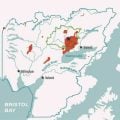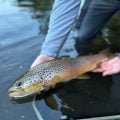Making Do with the Wrong Fly Rod

Chester Allen photo
If you’re like me, you own too many fly rods — but you want and need even more.
I haven’t taken a formal census of my fly rods — that would take too much time away from actually fishing — but I own a lot of them.
I’ve recently embraced trout spey AND Euro nymphing, so I’ve got some new rods in serious rotation. But I still use old-school, single-handed rods for most of my trout fishing.
So, it was a shock to arrive at Oregon’s Crooked River a few weeks ago — only to discover that I’d somehow left my favorite vintage Sage RPL 4-weight and 6-weight trout rods at home in Hood River. I’d also left my Winston 4-weight and my Sage Circa 4-weight — and my Sage LL 3-weight and my… Well, you get the idea.
My Sage 3-weight One Trout Spey and my Echo Shadow II 3-weight Euro nymphing rod were the only rods in the back of the truck. The Crooked River is about 130 miles from Hood River, so circling back home wasn’t an option.
How did this happen?
You’ll Get the Coyote
The Crooked is a fairly small tailwater river that flows out of Bowman Dam and through sagebrush-dotted basalt canyons. It eventually flows into the Deschutes River. I love the contrast between the arid, rocky canyon and the rich, cool, weedy river crammed full of Redside rainbow trout —and a lot of whitefish.
Imagine a lush spring creek flowing through a sagebrush-and-juniper desert. That’s the Crooked River.
A few years ago, during a FFI gathering in Bend, Oregon, I found an angler from Pennsylvania’s spring creek country on the Crooked.
“It’s just so damn weird to see rising trout in what looks like a set for a western movie,” he said. “I keep waiting for the cattle drive and the howling coyote.”
“If you stick around till dark, you’ll get the coyote,” I said.
Anyway, there I was, owner of at least two dozen fly rods, but armed with two rods that weren’t designed for throwing tiny dry flies at rising trout. My truck is always loaded with fly-fishing gear. In fact, I bought the truck to lug me — and my equipment — on fishing trips around the western United States.
One Rod at a Time
I feel like fly fishing is drifting toward golf — different rods for very different ways of showing a fly to the trout. We have dry-fly rods, super-light dry fly rods, nymphing rods, streamer rods, spey rods, trout spey rods and on and on and on.
And there are now hundreds of specialty fly lines.
For example, my Sage One Trout Spey is a 3-weight rod, but the 3-weight line it throws is nothing like the Euro nymphing 3-weight line on the Echo rod. Going further, a Euro nymphing line is nothing like a regular trout fishing line. A Euro nymphing line is soft and supple —more like backing than a regular fly line.
Golfers tote around different clubs for different situations. The same thing is happening for fly anglers and fly rods.
Golfers have bags and carts for their clubs. Most fly anglers just buy trucks or SUVs. On this day, I had the truck and lots of gear — but the right rods were still at home.
How my wife would have loved that moment.
“You can only fish one fly rod at a time,” Heather likes to say whenever I buy a new rod. That’s the moment when I open her closet door and gaze at ranks of cherished shoes and handbags.
A tiny moral victory — well, at least an honorable stalemate — at home is great, but I was still stuck with the wrong fishing tools.
The 3-weight Trout Spey is a great streamer rod, but it’s too much rod for the modestly sized trout in the Crooked River.
Sure, I could Euro nymph the Crooked — and probably do pretty well — but what about that evening, when the river came alive with trout rising for hatching caddis?
Agony, I guessed.
With a Little Help from a Friend
Then I remembered something my longtime friend Jeff Perin told me when he sold me the Echo rod. Jeff owns The Fly Fisher’s Place in Sisters, Oregon, and he probably owns 100 fly rods.
“This is also a pretty fair dry-fly rod,” he said. “It is pretty accurate, and the rod was designed to cushion light tippets.”
I rummaged around in my fishing duffle and found a Ross Gunnison reel with a weight-forward 3-weight line.
I rigged up the rod to Euro Nymph — with a different reel loaded with a Euro nymph line, but I tucked that spare reel in the back of my vest.
A hour later, I was a pretty happy angler. Euro nymphing looks damn weird — you mostly lob this really long, light leader, which allows the little, heavily weighted nymphs to sink like rocks and get down to the fish.
You use the long rod to gently lead the flies on a drift. The line is tight, and lots of times you feel the fish suck in the bug. Very, very cool. Other times, the sighter — a multi-colored length of monofilament in the leader — twitches or goes sideways when the trout eats.
I even hooked and landed a 18-inch redside. The Crooked is a rich, weedy tailwater with thousands of trout — and those whitefish — per mile, but 18-inchers are pretty rare.
Then the caddis cranked up — and so did the trout. Dozens of fish porpoised on emerging bugs all around me.
Making It Happen
I put the reel with the weight-forward 3-weight line onto the Euro rod. I tied on a size 16 X-Caddis and gingerly cast toward a riser.
That 10-foot rod rolled out a nice loop!
I was so surprised — I always think of this rod as a tool that lobs out long leaders and heavy flies — that I missed the fish when it ate the X-Caddis.
For the next few hours — until the coyotes started howling at the rising moon — I cast to rising trout while swarms of flying caddis peppered my face. The rod was a decent caster — especially for downstream reach casts. That extra foot of rod moved a lot of line.
I got home that night feeling good about catching a few fish — and discovering that my Euro nymph rod could do more than one thing. I think I’m going to keep that extra reel with the 3-weight line in my vest — just in case I need to turn my Euro nymph rod into a regular rod again.
The load never, ever gets lighter.
When I got home, I walked into my home office, and there were those two missing Sage rods — right by the door, so I wouldn’t forget them.
I picked them right up and put them in the truck. You can never have too many fly rods — even if some of them are more versatile than advertised.











